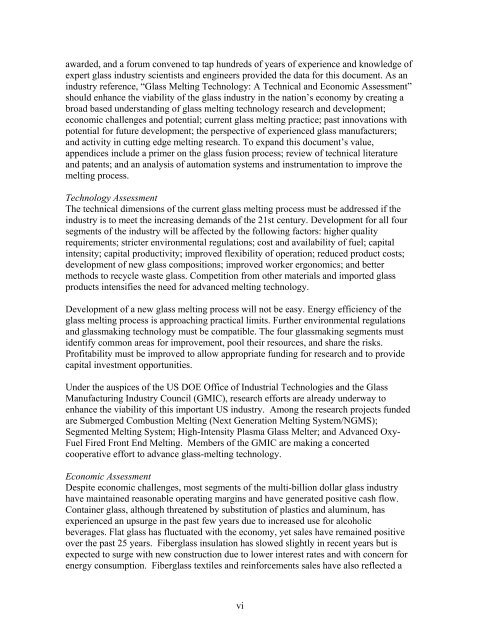Glass Melting Technology: A Technical and Economic ... - OSTI
Glass Melting Technology: A Technical and Economic ... - OSTI
Glass Melting Technology: A Technical and Economic ... - OSTI
You also want an ePaper? Increase the reach of your titles
YUMPU automatically turns print PDFs into web optimized ePapers that Google loves.
awarded, <strong>and</strong> a forum convened to tap hundreds of years of experience <strong>and</strong> knowledge of<br />
expert glass industry scientists <strong>and</strong> engineers provided the data for this document. As an<br />
industry reference, “<strong>Glass</strong> <strong>Melting</strong> <strong>Technology</strong>: A <strong>Technical</strong> <strong>and</strong> <strong>Economic</strong> Assessment”<br />
should enhance the viability of the glass industry in the nation’s economy by creating a<br />
broad based underst<strong>and</strong>ing of glass melting technology research <strong>and</strong> development;<br />
economic challenges <strong>and</strong> potential; current glass melting practice; past innovations with<br />
potential for future development; the perspective of experienced glass manufacturers;<br />
<strong>and</strong> activity in cutting edge melting research. To exp<strong>and</strong> this document’s value,<br />
appendices include a primer on the glass fusion process; review of technical literature<br />
<strong>and</strong> patents; <strong>and</strong> an analysis of automation systems <strong>and</strong> instrumentation to improve the<br />
melting process.<br />
<strong>Technology</strong> Assessment<br />
The technical dimensions of the current glass melting process must be addressed if the<br />
industry is to meet the increasing dem<strong>and</strong>s of the 21st century. Development for all four<br />
segments of the industry will be affected by the following factors: higher quality<br />
requirements; stricter environmental regulations; cost <strong>and</strong> availability of fuel; capital<br />
intensity; capital productivity; improved flexibility of operation; reduced product costs;<br />
development of new glass compositions; improved worker ergonomics; <strong>and</strong> better<br />
methods to recycle waste glass. Competition from other materials <strong>and</strong> imported glass<br />
products intensifies the need for advanced melting technology.<br />
Development of a new glass melting process will not be easy. Energy efficiency of the<br />
glass melting process is approaching practical limits. Further environmental regulations<br />
<strong>and</strong> glassmaking technology must be compatible. The four glassmaking segments must<br />
identify common areas for improvement, pool their resources, <strong>and</strong> share the risks.<br />
Profitability must be improved to allow appropriate funding for research <strong>and</strong> to provide<br />
capital investment opportunities.<br />
Under the auspices of the US DOE Office of Industrial Technologies <strong>and</strong> the <strong>Glass</strong><br />
Manufacturing Industry Council (GMIC), research efforts are already underway to<br />
enhance the viability of this important US industry. Among the research projects funded<br />
are Submerged Combustion <strong>Melting</strong> (Next Generation <strong>Melting</strong> System/NGMS);<br />
Segmented <strong>Melting</strong> System; High-Intensity Plasma <strong>Glass</strong> Melter; <strong>and</strong> Advanced Oxy-<br />
Fuel Fired Front End <strong>Melting</strong>. Members of the GMIC are making a concerted<br />
cooperative effort to advance glass-melting technology.<br />
<strong>Economic</strong> Assessment<br />
Despite economic challenges, most segments of the multi-billion dollar glass industry<br />
have maintained reasonable operating margins <strong>and</strong> have generated positive cash flow.<br />
Container glass, although threatened by substitution of plastics <strong>and</strong> aluminum, has<br />
experienced an upsurge in the past few years due to increased use for alcoholic<br />
beverages. Flat glass has fluctuated with the economy, yet sales have remained positive<br />
over the past 25 years. Fiberglass insulation has slowed slightly in recent years but is<br />
expected to surge with new construction due to lower interest rates <strong>and</strong> with concern for<br />
energy consumption. Fiberglass textiles <strong>and</strong> reinforcements sales have also reflected a<br />
vi

















